Last Updated: January 2025
The ieGAT is a challenging admission test created by IE University that will thoroughly examine your numerical, verbal, and abstract reasoning abilities under a tight time limit. Since the ieGAT exam can only be taken once, the stakes are high and the resulting stress can damage your score.
This is why focused preparation for the ieGAT Test is key, and with our accurately and expertly designed ieGAT Test preparation pack you will get everything you need to ace the test, including:
- Realistic timed tests to improve time management under pressure
- Verbal Reasoning tests to quickly find relevant information.
- Numerical Reasoning Tests to enhance math skills and data analysis.
- Abstract Reasoning Tests to master hidden rules and tricky patterns.
For the computerized test version:
- 5 Verbal Reasoning Practice Tests
- 6 Numerical Reasoning Tests
- 9 Abstract Reasoning Tests
For the pen-and-paper test version:
- 1 Numerical / Verbal Test Simulation
- 14 Numerical Reasoning Tests
- 17 Verbal Reasoning Tests
- 10 Abstract Reasoning Tests
Both versions include dozens of additional study guides, video tutorials, and exercises
What is the ieGAT
The ieGAT Test (IE Global Admissions Test) was created by the IE International University (IEU) as a substitute for the GMAT, GRE, or LSAT tests. The ieGAT admission Test is very challenging because it adapts to your individual response level, meaning the level will become increasingly difficult as you answer more questions correctly early on.
Another unique attribute of the ieGAT exam is that there is negative scoring for wrong questions and your ranking is determined by both your speed and accuracy, adding extra difficulty to this already challenging admissions test.
Although the ieGAT test does not assess academic skills, it does evaluate your ability to think critically and comprehend scenarios from texts and numbers - all under significant time pressure and the fatigue of an 80-90 minute test.
ieGAT Video Tutorial
Check out our video, where we go over the various elements of the ie Global Admissions Test and discuss useful solving tips.
ieGAT Practice Test Questions
The ieGAT exam, developed by IE University, is 80 to 90 minutes long with no breaks, and includes 129 verbal, numerical, and abstract reasoning questions which appear in random order and are divided as follows:
- Verbal Reasoning - 50 questions
- Numerical Reasoning - 56 questions
- Abstract Reasoning - 23 questions
Please note that there are differences between the paper and online versions of the ie Global Admissions Test - we'll dive into those further down the page.
ieGAT Verbal Comprehension and Reasoning
On the verbal reasoning section of the ieGAT exam, you will need to read a passage and answer two questions. The texts will often discuss economic topics, such as unemployment or GDP.
The questions aim to determine your comprehension of written professional English, and are multiple-choice. For some questions, you may be asked to choose more than one answer from the list.
Verbal Comprehension ieGAT Test Sample Question
Below you will find six tabs. Click on them to read the data, and answer the sample questions.






Question 1:
The Arclight Computers Group’s marketing department is effective to the point that it has managed to turn the relatively new group into Arclight’s most recognisable
ieGAT Verbl Reasoning Preparation
Sharpen your verbal and reading comprehension skills and master the ieGAT exam with over 20 practice tests for both the computerized and pen-and-paper versions of the test, study guides, and video tutorials!
ieGAT Numerical Comprehension, Reasoning, and Calculation
The main goal of this section of the ieGAT exam is to assess your quantitative reasoning skills rather than your knowledge in specific mathematical fields such as geometry or algebra.
In these questions, information is presented in graphs and data tables. You need to read the information, analyze it, and make quick and accurate calculations.
Numerical Reasoning ieGAT Test Sample Question
Below you will find six tabs. Click on them to read the data, and answer the two sample questions.
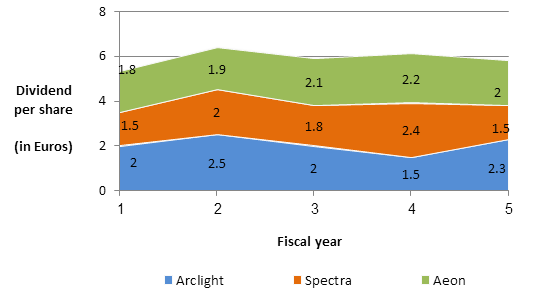
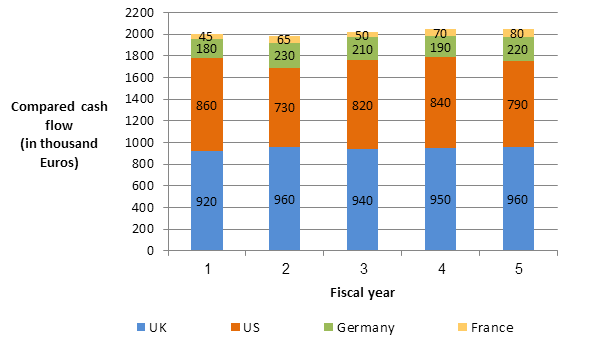
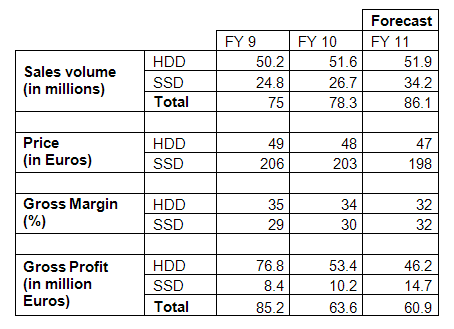
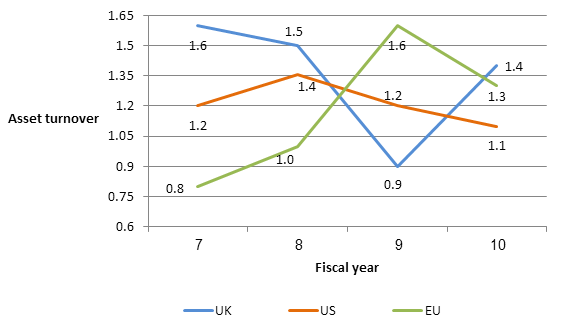

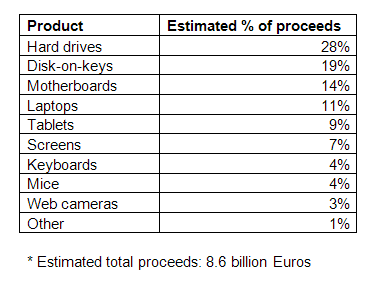
Question 1:
Although taxes increased in January of fiscal year 9 compared with January of the previous fiscal year, sales increased as well, generating higher revenues in January of fiscal year 9.
ieGAT Numerical Reasoning Preparation
Refresh your numerical comprehension and prepare for the ieGAT exam numerical reasoning types of questions with 20 practice tests, extra exercises, and scoring reports, allowing you to keep track of your performance!
ieGAT Logical / Abstract Reasoning
This section of the ieGAT exam includes a number of diagrammatic, logical, and abstract reasoning tests in which you are given a series of figures and a symbol representing an operation. Based on the changes you observe in the figure after the symbol, your task is to identify the role of the symbol.
To do this successfully, you must have strong visualization skills and be able to envision multiple shapes at one time.
Logical Reasoning ieGAT Test Sample Question
Please select one correct answer:
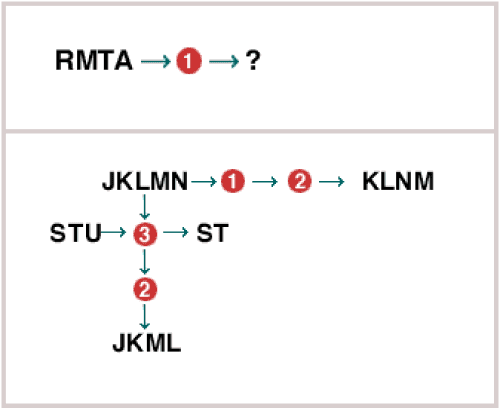
ieGAT Logical Reasoning Preparation
Boost your logical abilities and conquer the ieGAT exam with 19 practice tests for inductive and deductive reasoning, study guides showing you how to approach these questions, and scoring reports highlighting your strengths and weaknesses!
How to Prepare for the ieGAT Test?
The ieGAT exam is highly challenging and competitive, and your score is heavily influenced by your level of expertise in answering its unique questions.
That’s why it is important to take this admissions test only after thorough and accurate practice - exactly the type of practice you will find in our ieGAT PrepPack, which includes:
The ieGAT Online Preparation
Our experts have researched and perfected an online practice pack designed mock the challenges you'll face in the ieGAT test.
Realistic Simulations
Improve time management and adapt to the pressure.
Expert Guidance to Perfect Answers
Get feedback with guidance written by assessment centre experts.
Personalized for Your Best Score
Identify weak areas to focus your practice for the best score.
How Does the ieGAT Scoring Work?
The ieGAT scoring system is based on the profile of successful IE University graduates, and places the test scores on a Gauss curve that compares the candidate's abilities and skills to top students in all IE University programs.
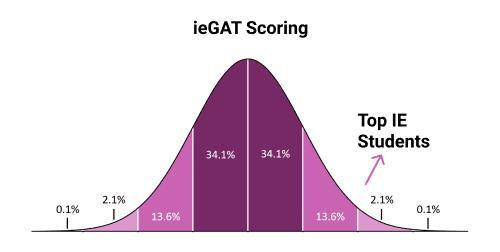
Backed By Over 2k+ Candidates
ieGAT Formats: Pen & Paper, and Online
ieGAT Pen & Paper Format
In the verbal / numerical reasoning section of the pen & paper format of the ieGAT you will be presented with four economic texts, each followed by nine questions including both verbal reasoning and numerical reasoning questions.
All questions are multiple-choice with four options to choose from, and sometimes there will be more than one correct answer.
In the second section of the admissions test, you are given a variety of logical and abstract reasoning questions (similar to those found in the online version of the test). The number of questions per category in the second section varies, but there are approximately six questions per category.
In total, the test includes four numerical / verbal reasoning sections and four logical thinking sections containing 60 questions, with a time limit of 80 minutes.
ieGAT Online Format
In the online version of the ieGAT Test, a facilitator sets up an online chat room, and all test takers are instructed to switch on their computer's camera.
The online version consists of a variety of multiple-choice questions in which you will be given the following options to answer: true, false, or cannot say.
The ieGAT Online Format takes approximately 90 minutes to complete and includes seven sections, each with their own instructions and time constraints:
Conditions for Taking the Test and Receiving Results
You need to make all the necessary payments and complete at least 25% of your application before you are allowed to take the test. If these requirements are not met, you will be unable to take the test.
Also, you have 30 days after taking the ieGAT Test to complete your online application and receive your results. If you do not submit your online application on time, you will lose your ieGAT result and will be required to submit alternative test scores.
Join the 95% of our users who scored above average after using our PrepPack!
- Full time-limited simulations mimicking the real tests and enhancing your time management and efficiency
- Verbal, Numerical, and Logical reasoning practice tests and extra drills improve the skills needed for each section of the ieGAT exam
- Study guides & video tutorials walking you through the different sections of the test
- Scoring reports highlighting the areas in which you shine and where you need to focus your efforts
FAQs
The ieGAT, or IE Global Admissions Test, is a rigorous entrance exam developed by IE University to assess candidates' cognitive abilities and reasoning skills under strict time constraints.
It spans 80 to 90 minutes without breaks and features 129 questions that test verbal, numerical, and abstract reasoning in a random sequence.
This one-time test demands high performance in critical thinking and comprehension of both textual and numerical information, with a scoring system that factors in both speed and accuracy, making thorough preparation essential for success.
The ieGAT, also known as the IE Global Admissions Test, is an admission test developed by IE University to assess candidates' numerical, verbal, and abstract reasoning skills under significant time pressure. Since you can take it only once, the ieGAT exam is highly stressful, and the adaptive difficulty and negative scoring for wrong answers add to its challenge.
The ieGAT exam, also called the IE Global Admissions Test, was developed by IE University and is designed to test cognitive abilities under significant time pressure. It lasts 80 to 90 minutes, with no breaks, and includes 129 questions covering verbal, numerical, and abstract reasoning in a randomized order.
While the GMAT requires preliminary knowledge in specific mathematical fields - algebra, geometry, probability and more - the ieGAT test does not, but rather examines your basic arithmetic concepts including the four operations, percentages, and ratios.
The ie Global Admissions Test highly resembles the aptitude tests used by employers, with slight changes In content and context. Therefore, you are likely to encounter tasks similar to those that are given at assessment centers and online screening tests, i.e. numerical critical reasoning, verbal critical reasoning and logical reasoning.
Yes, you can still take the ieGAT exam even if you have already taken the GMAT. When considering applications, the admissions committee accepts all test scores and if you have a valid GMAT score, you should report it when applying for the ieGAT.



